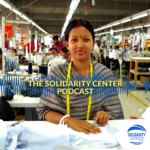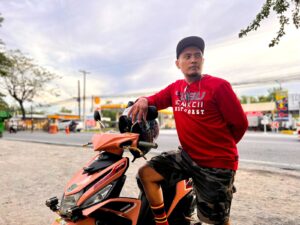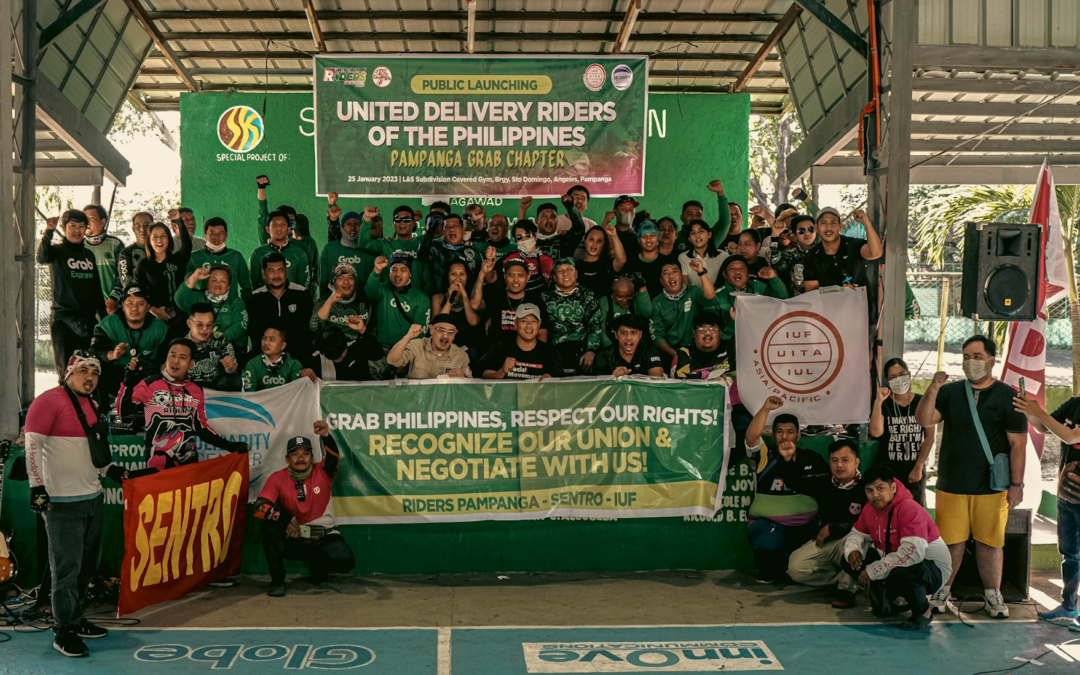
“Recognize our union; negotiate with us!” Pampanga Delivery drivers cried last January 25 during the launch of the Pampanga chapter of the National Union of Delivery Riders (RIDERS). Intending to cover all platform-based delivery drivers from apps like Grab, FoodPanda and Maxim, RIDERS fights for health insurance and income security, among other basic protections.

Mark Larson (left) and Mary Rose (right)
The Solidarity Center spoke to RIDERS organizers Mark Larson and Mary Rose, who were illegally terminated and suspended last December following a labor rally they both attended. They then filed a case with the National Labor Relations Commission (NLRC) and currently await the labor arbiter’s decision.
Greener Pastures in Delivery Work
“When Grab first opened in Pampanga around June 2019, we were only around 20 drivers,” says Larson.
Larson and Rose were among the pioneer Grab delivery drivers in their province. Before joining, Larson had worked as a fast-food delivery driver, and Rose was a migrant worker in Dubai. Both were enticed to join Grab because it held the opportunity of reasonable wages and flexible work hours. Both Larson and Rose are their respective families’ breadwinners, with Rose being a single mother of five and Larson supporting his family of six.
 |
 |
Mark (left) and Rose (right) are with their family. Faces blurred for privacy.
In the Philippines, apps like Grab utilize a cash-on-delivery system that makes delivery drivers like Larson and Rose temporarily pay for their customer’s food order. The customer then pays the delivery drivers back once they receive their order. This opens up the possibility of fake bookings, such as when the customer never claims the food.
Cracks in the System
Emerging from the pandemic, food delivery services became typical for Filipinos. The delivery boom necessitated Grab to add more delivery drivers. Research conducted in 2022 by Fairwork Philippines estimates that Grab employs 40,000 delivery drivers. Its competitor, Foodpanda, employs 45,000.
However, increasing delivery drivers meant steeper competition, and fewer bookings meant less income. “Before, working late into the night was a choice. Now it is a necessity,” says Rose. “Despite consistent good performance, it is a game of chance— some accounts have stronger bookings on some days and slower bookings on others,” Larson adds.
The incentive system they used before the pandemic was also adjusted. “They may have raised the incentive amount, but they also raised the number of rides you will need to reach it. In the end, the delivery driver loses,” says Rose.
While delivery drivers in Pampanga have been complaining about these issues, the push for collective action came when Grab informed the delivery drivers that they would implement fare changes. On the day Grab Pampanga implemented the announced fare change, Pampanga delivery drivers were shocked to find fares that went below 38 pesos (about 69 cents).
Grab Pampanga’s Pricing Matrix Provided to GrabFood Delivery Drivers, 2022
|
Distance |
Pax Fare (old, peso) |
Pax Fare (new, peso) |
Dax Fare (old, peso) |
Dax Fare (new, peso) |
|
0-1.5km |
49 |
28 |
51+ |
34+ |
|
1.5-3km |
49 |
38 |
61+ |
62+ |
|
3-5.5km |
59 |
48 |
95+ |
73+ |
|
5.5km up |
79 |
58 |
110+ |
81+ |
Pax refers to the net income of the delivery driver per transaction. Dax is what the customer will pay. The difference between the two (Dax minus Pax) is what goes to Grab. Example computations change the base rate of around 49 pesos (about 89 cents) to 38 pesos (about 69 cents).
The Breakthrough
Larson remembers the anger and confusion that delivery drivers felt when they saw how little they would make, considering that they needed to spend their money on motorcycle maintenance, gas, mobile data and cellular load, and delivery boxes.
 When management informed the delivery drivers of the change in late 2022, it was through a Zoom call where comments were screened and monitored. Grab Pampanga did not seek prior input from delivery drivers. “We also have a Discord channel with the management, but they usually just mute the chat when they don’t want to be bothered,” explains Larson.
When management informed the delivery drivers of the change in late 2022, it was through a Zoom call where comments were screened and monitored. Grab Pampanga did not seek prior input from delivery drivers. “We also have a Discord channel with the management, but they usually just mute the chat when they don’t want to be bothered,” explains Larson.
He continues, “Delivery drivers within their areas started talking to each other, and agreed to do a motorcade and noise barrage. Almost 600 delivery drivers were a part of that first rally.”
At the time, since Larson was the team leader in his area, his fellow delivery drivers asked him to go to the Grab Pampanga management office to communicate their demands. Weeks of negotiating with management proved to be unfruitful. “They told us it was a system error, but they don’t know when it would be corrected. They said their hands were tied because they didn’t have access to the fare matrix. They only follow what the main office tells them,” Larson says.
At that point, the Pampanga management team regarded Larson as the spokesperson of the delivery drivers, specifically those who had rallied. He was given a warning because he allegedly violated the company’s code of conduct and was called to a meeting. Rose, who was present during the rally, was also issued a warning. During their meeting, management purported that Larson was the leader of the rally, and that Rose was wearing Grab’s uniform during the rally. A second meeting was called, which coincided with a planned labor rally. After attending the second rally, Larson was terminated, while Rose was indefinitely suspended.
Call to Action
“Ultimately, they’re [Grab] the ones who pushed us to unionize,” Rose says. Rose and Larson eventually attended orientation seminars and training on trade unionism and worker rights. Together with other delivery drivers, they formed the Pampanga Chapter of the United Delivery Riders of the Philippines (RIDERS).
“We saw that it was the only way for us to fight for our rights. Because if we do it individually, they will never notice us. They would just terminate us, and we would have a hard time fighting back,” says Larson, “At least now that I have a union to support me, I can fight.”
“The number one reason delivery drivers are scared,” Larson says, “is because they believe that they are not employees of the app.” In the Philippines, no specific labor law has provisions for workers in the gig economy. However, a recent ruling from the Supreme Court established an employer-employee relationship between Lazada, an e-commerce platform and its delivery drivers. Larson and Rose are hopeful that this can be the start of future legislation for delivery drivers.
 Larson and Rose’s pending case with the NLRC has yet to be settled. Rose has since been reinstated but continues to fight and organize.
Larson and Rose’s pending case with the NLRC has yet to be settled. Rose has since been reinstated but continues to fight and organize.
When Rose was asked why she continues to fight, she replied, “When you see your dignity being stepped on, you must stand up for yourself. We don’t have laws for us [delivery drivers]. Unionizing is how not only the company but also the government will notice us.”
You may follow RIDERS-SENTRO on their Facebook page for more updates at: https://www.facebook.com/UnitedDeliveryRidersOfThePhilippines
Contact them through Solidarity Center’s office in the Philippines at [email protected], or their email at: [email protected].

